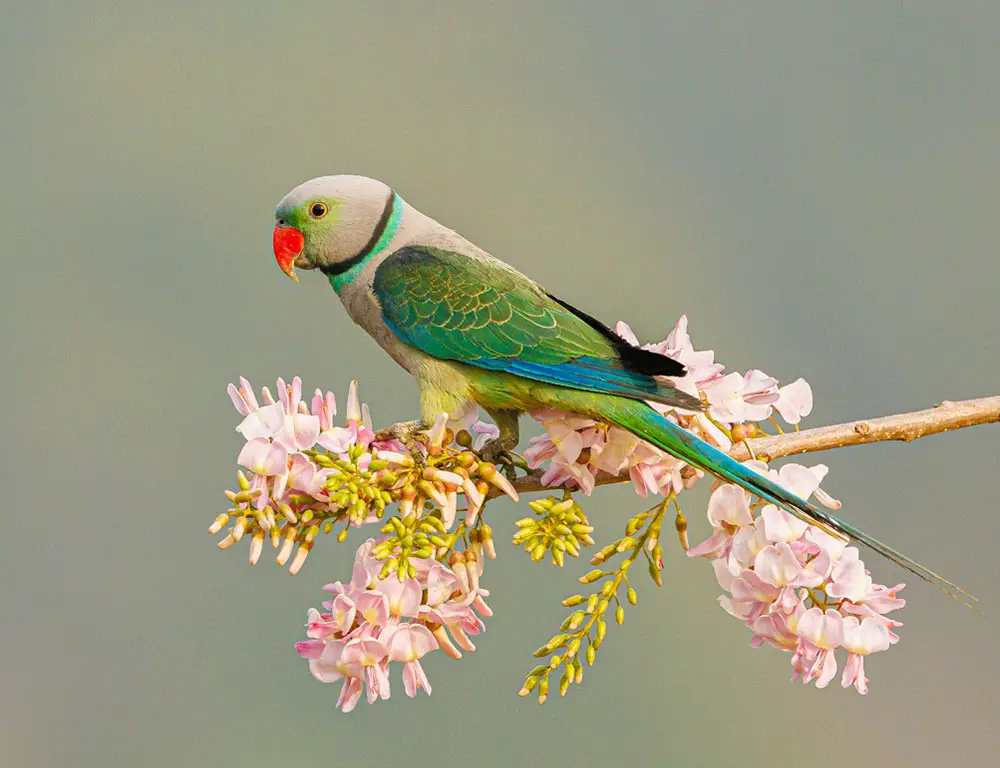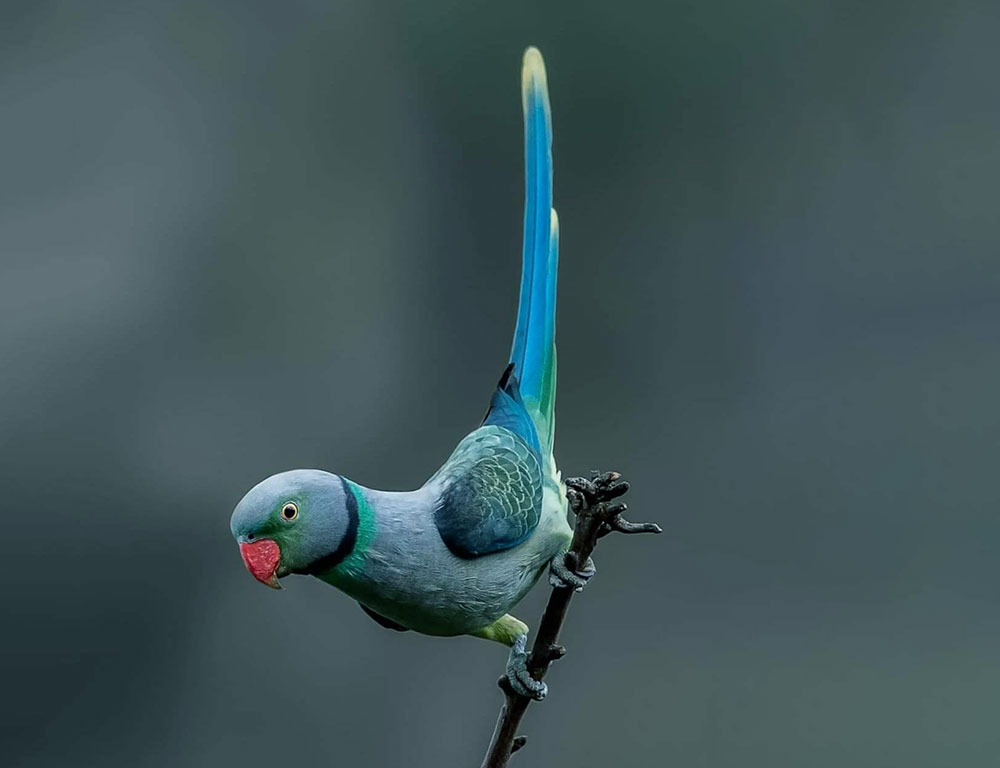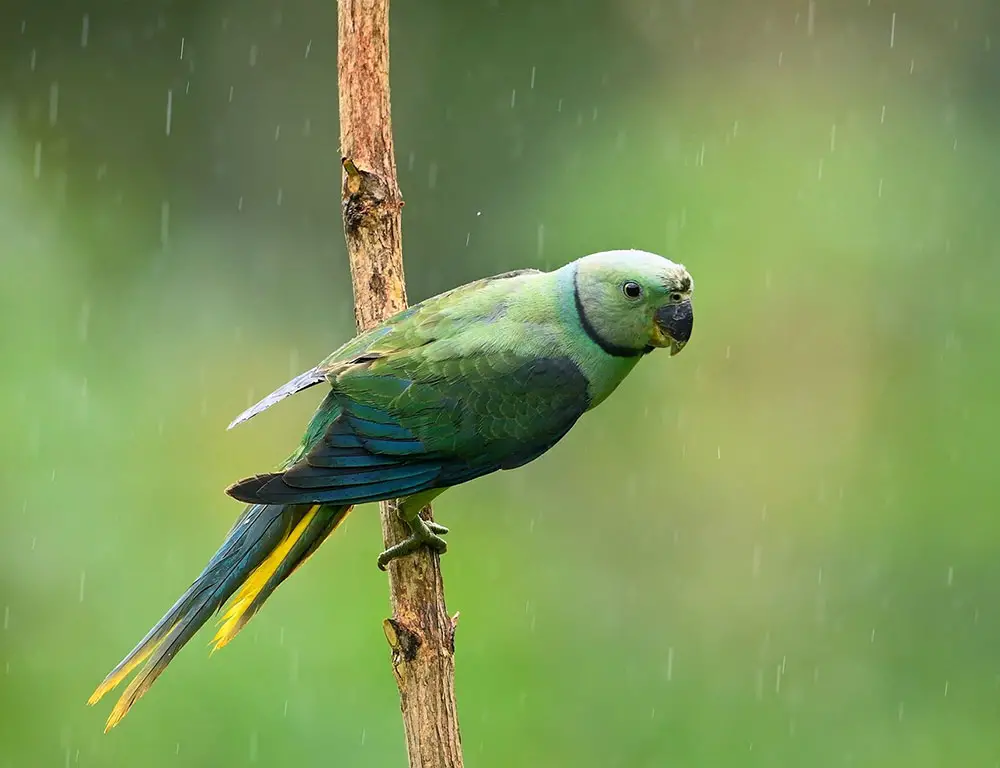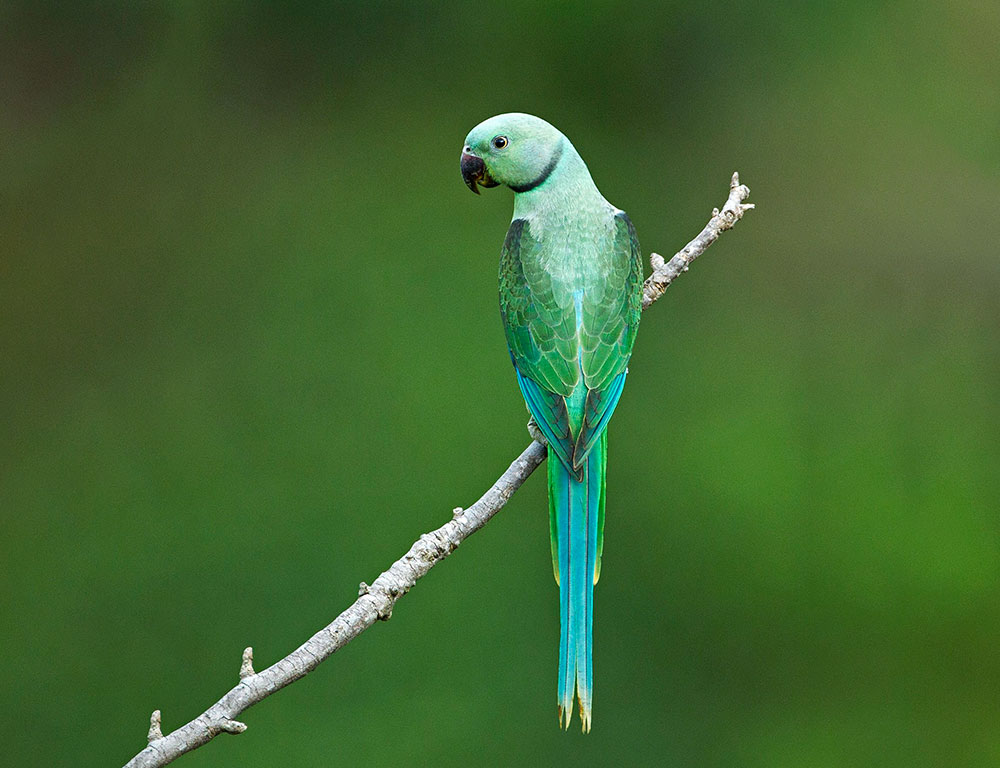As a bird enthusiast, I’m always thrilled to share insights on the diverse species that grace our skies. One such marvel is the Blue-Winged Parakeet, also known as the Malabar Parakeet.
Native to the western Ghats of southern India, this parakeet is a sight with its vibrant blue wings and tail feathers. It’s not just their beauty that captivates but also their distinctive behavior and vocalizations.
The Blue-Winged Parakeet thrives in undisturbed forests and plantations, carving out nests in tree cavities and displaying a strong preference for fruiting trees.
They are monogamous birds, sticking with one partner throughout their lifetime – a trait that adds charm to these already fascinating creatures.
With their mesmerizing coloration and intriguing habits, Blue-Winged Parakeets offer a perfect example of nature’s boundless creativity.
As we delve into their world, we’ll learn more about these captivating creatures – from their diet and breeding patterns to conservation efforts to preserve them.
Physical Characteristics of the Blue-Winged Parakeet

The Blue-Winged Parakeet, also known as the Malabar Parakeet, is indeed a captivating bird with a distinct set of physical characteristics:
Size and Proportions
With a length typically ranging from 37 to 42 centimeters, the Blue-Winged Parakeet is of medium size, comparable to the length of a standard ruler.
Its wingspan is equally impressive, spanning an average of 15 to 18 centimeters, providing the necessary surface area for efficient flight.
Coloration
While its body is primarily adorned in a dazzling shade of green, what truly catches the eye are the hues of blue and yellow that adorn its wings. This unique and vibrant color combination is a distinctive feature of the Blue-Winged Parakeet, making it instantly recognizable.
Beak
The parakeet’s beak is a sturdy and curved tool, perfectly adapted for its seed-based diet. Colored in a contrasting greyish-black, the beak adds visual interest against the predominantly green plumage.
Tail
Beyond being decorative, the parakeet’s tail also serves a functional purpose. It acts as a balancing tool, particularly useful when the bird is perched high on tree branches, ensuring stability and agility in its arboreal habitat.
Eyes
One of the most striking features of the Blue-Winged Parakeet is its eyes. The iris displays a captivating white-blue color, encircled by an unfeathered eyering, adding a touch of elegance to its overall appearance.
Habitat and Distribution of the Blue-Winged Parakeet

With its remarkable adaptability, the Blue-Winged Parakeet finds its habitat primarily in the verdant landscapes of South India and Sri Lanka and within the wooded habitats of the Western Ghats.
Here’s a closer look at their habitat and distribution:
Regions
- South India: These parakeets are prevalent across South India, where they inhabit various habitats, from moist deciduous forests to evergreen jungles.
- Sri Lanka: Similarly, they thrive in the lush greenery of Sri Lanka, making their homes in diverse environments.
- Western Ghats: Known for their biodiversity, the Western Ghats provide a rich habitat for the Blue-Winged Parakeet, allowing them to flourish in wooded areas.
Altitude
The adaptability of the Blue-Winged Parakeet is evident in its distribution, with sightings reported at heights of up to 2000 meters in the regions they inhabit.
Preferred Habitats
- Moist Deciduous Forests: These forests offer abundant food sources, including fruits, nuts, insects, and seeds, along with ample nesting opportunities within the dense tree cover.
- Evergreen Jungles: Like deciduous forests, evergreen jungles provide plentiful food and shelter for the parakeets.
- Wooded Habitats: Despite their adaptability, Blue-Winged Parakeets thrive even in less dense wooded areas, showcasing their versatility in habitat selection.
Here’s a quick look at some statistics:
| Region | Altitude |
|---|---|
| South India | Up to 2000m |
| Sri Lanka | Up to 2000m |
| Western Ghats | Up to 2000m |
Behavior and Diet of Blue-Winged Parakeets

The Blue-Winged Parakeet exhibits a fascinating array of behaviors and dietary preferences that reflect its adaptability and social nature.
Social Behavior
Blue-winged parakeets are highly social creatures, often forming small flocks and even joining forces with other parakeets. Their lively nature is evident in their high-pitched calls, which echo through their habitat.
Intelligence and Tool Use
These parakeets display intelligence in using their beaks as a ‘third hand’ for manipulating objects and foraging for food. This behavioral trait underscores their adaptability and problem-solving abilities.
Dietary Preferences
While primarily herbivorous, feeding on leaves, flowers, seeds, and berries, Blue-Winged Parakeets may also consume insects or larvae occasionally. This dietary flexibility likely contributes to their ability to thrive in various environments.
Feeding Habits
They tend to feed early in the morning and late afternoon, with periods of rest and meticulous preening. This feeding pattern optimizes their energy expenditure and foraging efficiency.
Breeding Behavior
Breeding season, typically between December and March, influences their behavior significantly. During this time, pairs break away from the flock to nest.
However, after the chicks have fledged, they return to their communal lifestyle, highlighting the importance of social bonds within the species.
Conservation Status of the Blue-Winged Parakeet

Despite its captivating appearance, the Blue-Winged Parakeet faces significant threats, leading to its classification as ‘Near Threatened’ by the International Union for Conservation of Nature (IUCN).
While not currently endangered or vulnerable, the species is perilously close to reaching those statuses due to several factors.
Habitat Destruction
One of the primary threats to Blue-Winged Parakeets is habitat destruction. Deforestation for agriculture, urban development, and logging activities diminishes their natural habitats, leading to the loss of nesting sites and food sources, particularly fruit trees found in rainforests and mangroves.
Illegal Pet Trade
The illegal pet trade also contributes to the declining numbers of Blue-Winged Parakeets in the wild. Despite legal protections against capturing and selling these birds, enforcement is often inadequate due to resource limitations and insufficient awareness among local communities.
Climate Change
Climate change poses a significant long-term threat to the survival of Blue-Winged Parakeets. Weather patterns can disrupt their breeding cycles and the availability of food sources, potentially leading to drastic declines in population over time.
Concerted conservation efforts are necessary to protect these charming creatures and prevent them from further decline. These efforts should include:
Habitat Protection and Restoration
Conservation initiatives should protect existing habitats and restore degraded ones wherever possible. This involves preserving critical forested areas and creating corridors to connect fragmented habitats.
Combatting Illegal Wildlife Trade
More robust enforcement measures and increased awareness campaigns are needed to combat the illegal pet trade. Cooperation between authorities, conservation organizations, and local communities is essential to address this threat effectively.
Climate Resilience
Conservation strategies should also consider the impacts of climate change on Blue-Winged Parakeets. This may involve implementing adaptive management practices to help these birds cope with changing environmental conditions.
Conclusion
I’ve spent several sections introducing you to the fascinating world of Blue-Winged Parakeets. Now, I’d like to wrap up by summarizing some key points and sharing my final thoughts.
Firstly, it’s crucial to remember that these birds aren’t just beautiful to look at with their striking blue wings; they’re also incredible creatures in their own right. They have complex social structures and advanced communication skills and play a critical role in our ecosystem.
Here’s a quick recap of what we’ve learned about Blue-Winged Parakeets:
- They’re native to South Asia.
- Their diet primarily consists of fruits, seeds, nuts, and berries.
- They can live up to 10 years or more in captivity.
Regarding conservation status, the Blue-winged Parakeet is classified as ‘Least Concern’ on the IUCN Red List. However, it’s worth noting that this doesn’t mean they’re free from threats.
Habitat loss due to deforestation and illegal pet trade are serious concerns that could affect their population in the future.
Lastly and most importantly – we must respect these creatures and their habitats. The beauty of biodiversity lies within its balance.
Each creature has a role within its ecosystem – including us humans! Understanding our impact on nature is vital to coexist peacefully with all living beings.
I hope you found this article informative and enjoyable! Remember: knowledge is power when it comes to conservation efforts.
Let’s do our part in preserving not only this intriguing species but our planet as well. After all, it’s not just about saving one species; it’s also about maintaining the delicate balance of life on Earth.